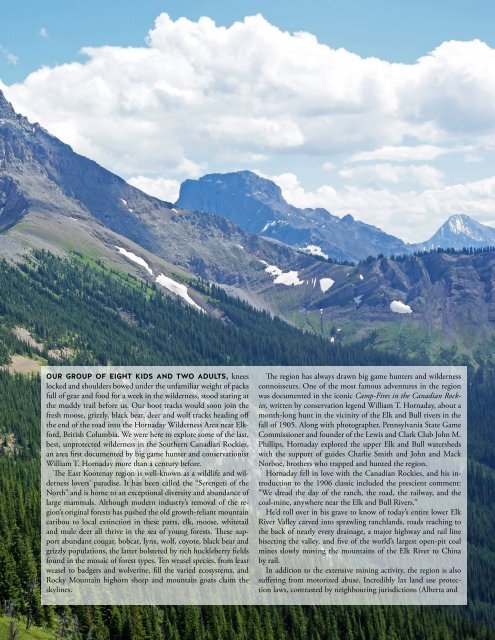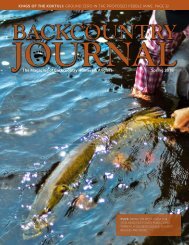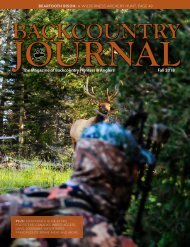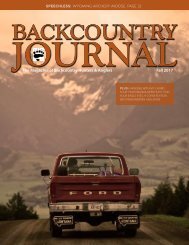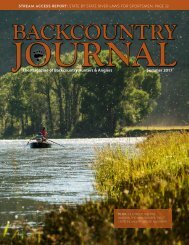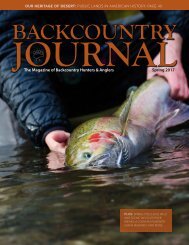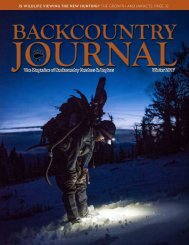BCJ_WINTER18 Digital Edition
Create successful ePaper yourself
Turn your PDF publications into a flip-book with our unique Google optimized e-Paper software.
OUR GROUP OF EIGHT KIDS AND TWO ADULTS, knees<br />
locked and shoulders bowed under the unfamiliar weight of packs<br />
full of gear and food for a week in the wilderness, stood staring at<br />
the muddy trail before us. Our boot tracks would soon join the<br />
fresh moose, grizzly, black bear, deer and wolf tracks heading off<br />
the end of the road into the Hornaday Wilderness Area near Elkford,<br />
British Columbia. We were here to explore some of the last,<br />
best, unprotected wilderness in the Southern Canadian Rockies,<br />
an area first documented by big game hunter and conservationist<br />
William T. Hornaday more than a century before.<br />
The East Kootenay region is well-known as a wildlife and wilderness<br />
lovers’ paradise. It has been called the “Serengeti of the<br />
North” and is home to an exceptional diversity and abundance of<br />
large mammals. Although modern industry’s removal of the region’s<br />
original forests has pushed the old growth-reliant mountain<br />
caribou to local extinction in these parts, elk, moose, whitetail<br />
and mule deer all thrive in the sea of young forests. These support<br />
abundant cougar, bobcat, lynx, wolf, coyote, black bear and<br />
grizzly populations, the latter bolstered by rich huckleberry fields<br />
found in the mosaic of forest types. Ten weasel species, from least<br />
weasel to badgers and wolverine, fill the varied ecosystems, and<br />
Rocky Mountain bighorn sheep and mountain goats claim the<br />
skylines.<br />
The region has always drawn big game hunters and wilderness<br />
connoisseurs. One of the most famous adventures in the region<br />
was documented in the iconic Camp-Fires in the Canadian Rockies,<br />
written by conservation legend William T. Hornaday, about a<br />
month-long hunt in the vicinity of the Elk and Bull rivers in the<br />
fall of 1905. Along with photographer, Pennsylvania State Game<br />
Commissioner and founder of the Lewis and Clark Club John M.<br />
Phillips, Hornaday explored the upper Elk and Bull watersheds<br />
with the support of guides Charlie Smith and John and Mack<br />
Norboe, brothers who trapped and hunted the region.<br />
Hornaday fell in love with the Canadian Rockies, and his introduction<br />
to the 1906 classic included the prescient comment:<br />
“We dread the day of the ranch, the road, the railway, and the<br />
coal-mine, anywhere near the Elk and Bull Rivers.”<br />
He’d roll over in his grave to know of today’s entire lower Elk<br />
River Valley carved into sprawling ranchlands, roads reaching to<br />
the back of nearly every drainage, a major highway and rail line<br />
bisecting the valley, and five of the world’s largest open-pit coal<br />
mines slowly moving the mountains of the Elk River to China<br />
by rail.<br />
In addition to the extensive mining activity, the region is also<br />
suffering from motorized abuse. Incredibly lax land use protection<br />
laws, contrasted by neighbouring jurisdictions (Alberta and<br />
WINTER 2018 2017 BACKCOUNTRY JOURNAL | 33


